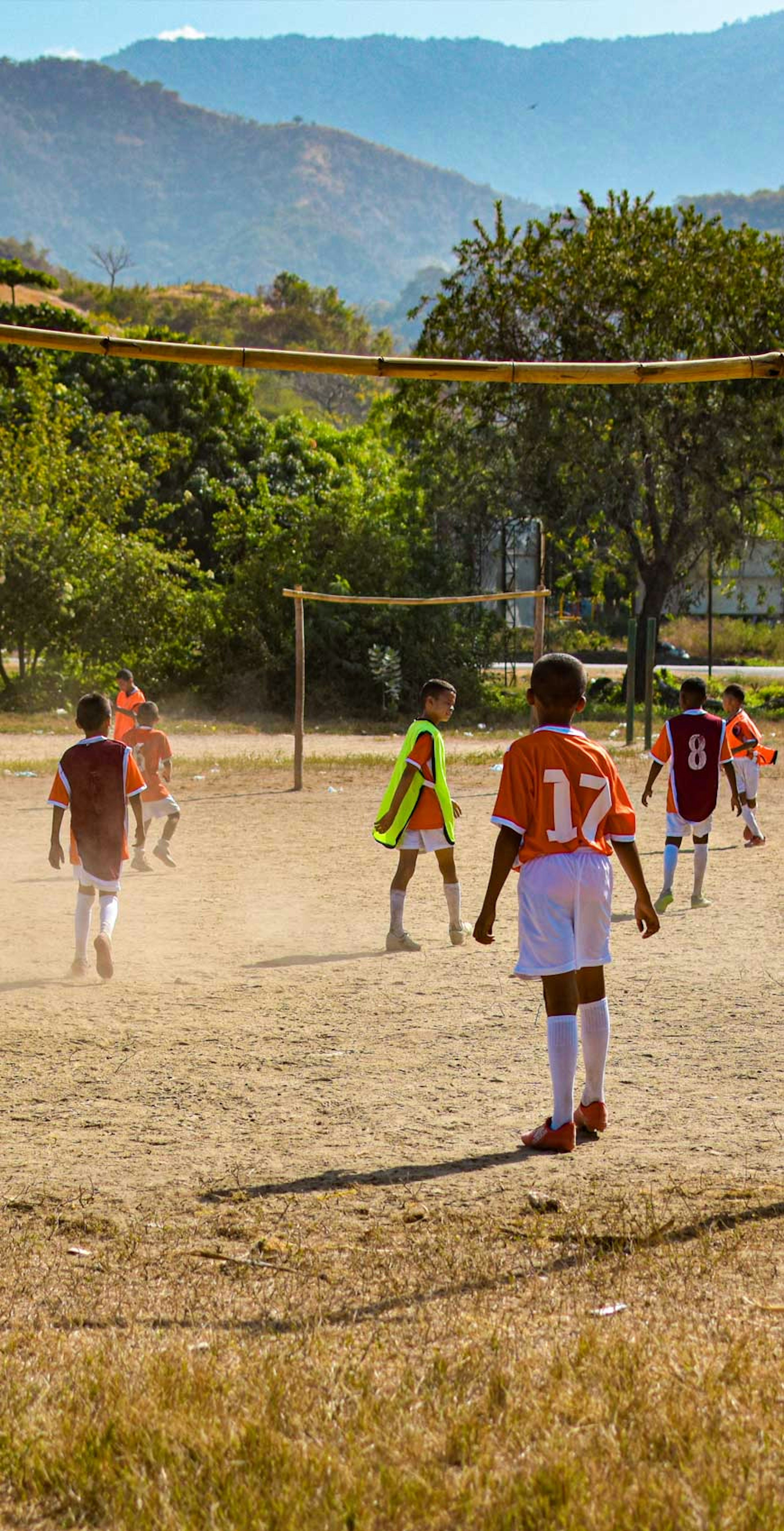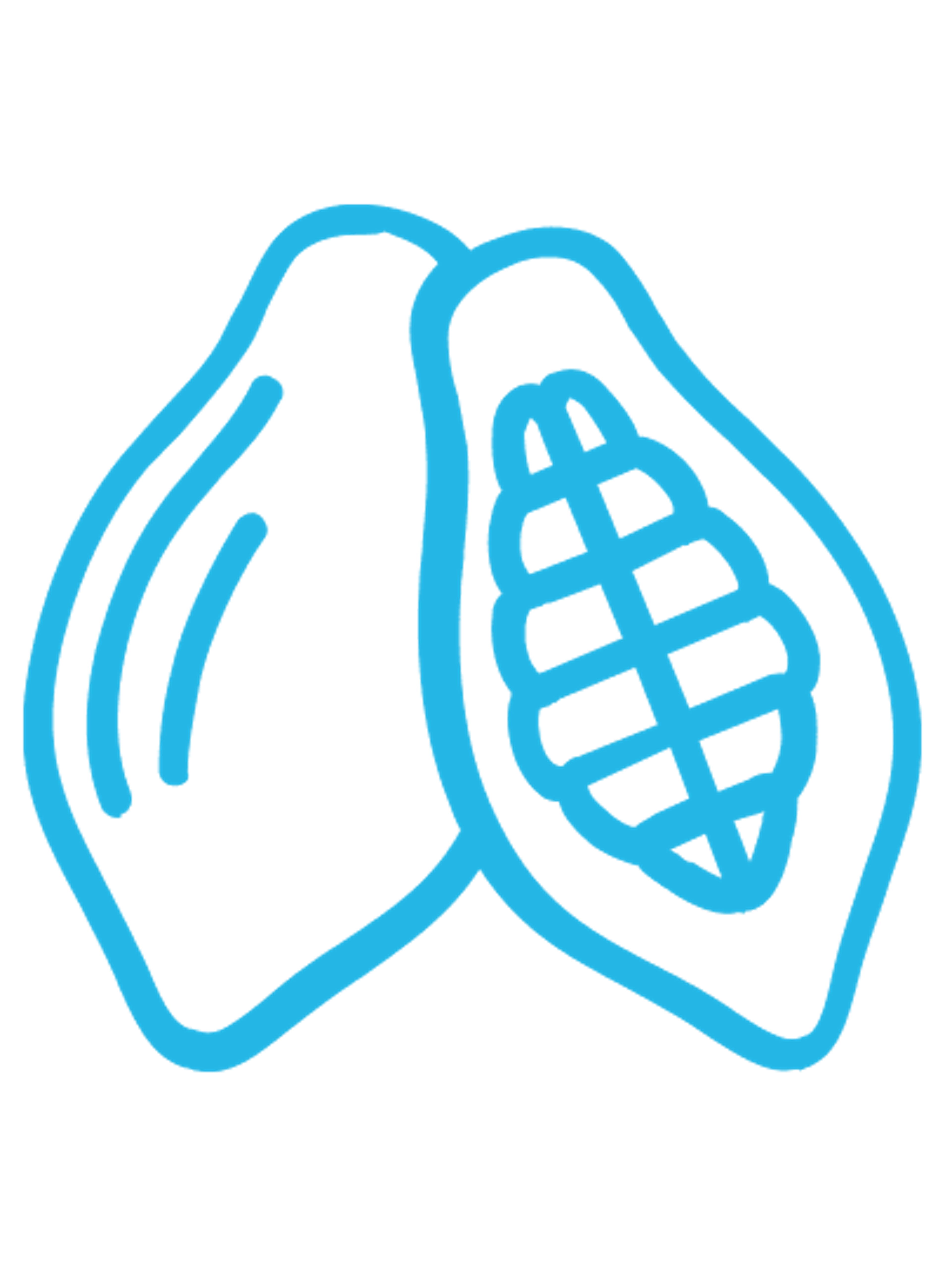Salient Issue
Child rights
Child labour, health hazards and other child rights violations are common in many countries and throughout global supply chains. It is estimated that 160 million children around the world – 70% of them in the agricultural sector – are engaged in work that threatens their health and safety or interrupts schooling.
Child Labour - Around the globe, child labour is widely documented in the production of gold (in 24 countries, as per US Department of Labour in October 2022), sugar (18), coffee (17), cotton (15), rice (12) and cocoa (7).
In Ghana and Côte d’Ivoire, where most of the world’s cocoa is produced, children constitute a third of the total workforce in cocoa production. It is estimated that approximately 1.56 million children – or 45% of the children living in cocoa growing areas – are engaged in child labour.
Children engaged in hazardous work or forced labour have been especially noted in sugar and West African cocoa production. This includes the use of sharp tools, exposure to hazardous chemicals, and carrying of heavy loads. Child labour risks are also present in the production of tea, bananas, wine grapes and textiles, as well as various vegetables, fruits, nuts, seeds and oils.
Information about child labour at the processing stage is scarcer, but underage workers have been found in pineapple processing factories in Thailand.
The COVID-19 pandemic exacerbated the risk of child labour, due to the closing of schools and the increased economic pressures on many families.
Health - Exposure to toxic substances represents another risk for many children, especially in the vicinity of gold mines and conventional banana plantations. Aerial spraying of pesticides on banana plantations can affect children living up to 1.5 kilometres away, hindering child and fetal development. Children living near to or working at artisanal gold mines are often exposed to toxic mercury, which is used for gold processing. This can cause brain damage and other serious conditions.
Safety – In India, child trafficking on tea plantations and forced child marriage among sugar cane workers are other high-risk areas. Mothers’ overtime work and long commutes can jeopardise the safety of children. Especially mothers working on flower, fruit and vegetable estates report that childcare facilities are inadequate and toddlers may spend long days alone with 10-year-old siblings. Carbon credit projects may require the relocation of entire communities, which disrupts children’s schooling for months or years.
Root Causes – Child rights violations have many root causes, but discrimination and poverty are the most prevalent. Given the low incomes and wages at farms, mines and textile factories, many households struggle to provide adequate nutrition and schooling for their children. When coffee prices fall, for example, adults in farming households often seek off-farm wage labour to make up for low income from coffee, which leaves children and adolescents to take on farm responsibilities at home. Further, many rural areas lack basic services such as schools, day cares and health facilities.

According to research
Fairtrade certified farmer organisations show positive effects on addressing child labour.
Review of research on Fairtrade from 2015-2020, 2022, page 32.

Action
Fairtrade's Response
Fairtrade works in supply chains where the risk of child labour is high (like sugar, cocoa, cotton and coffee), which is precisely where our work is most needed. The Fairtrade approach to child labour mitigation and remediation aspires to be fully human rights-based and inclusive while targeting direct root causes.
We support efforts by farmer organisations, plantations and other organisations using hired labour1 to utilise community-centred approaches to identify, mitigate, prevent and remediate abuse and exploitation of children. We also seek to facilitate dialogue among producer organisations, governments, traders and civil society organisations, so that solutions generated at the local level can be scaled up.
When child labour is found, Fairtrade supports producer organisations in protecting2 the affected person(s), working with national agencies, non-governmental organisations (NGOs) and the producer organisation towards the remediation and prevention of further cases. If child labour or related non-compliance with Fairtrade Standards is found via an audit, the independent Fairtrade auditor, FLOCERT, agrees on corrective actions and checks their implementation.
1: On this page, we use “plantations” to refer to organisations using hired labour.
2: Fairtrade’s Child Labour and Forced Labour Guidelines.
Fairtrade's response in detail
1: Preventive and mitigating measures
Fairtrade utilises a variety of tools to mitigate3 the risks of child labour and other child rights violations at farmer organisations and plantations.
The Fairtrade Standards are one of our tools and includes several child rights requirements:
- Prohibition of child labour - The Standards promote compliance with international standards, including the prohibition on child labour as defined by ILO conventions: All labour by children under the age of 15 and all work that jeopardises the schooling or health of under-18-year-olds.
- Risk Assessment - Farmer organisations need to assess the risk of child labour and, where the risk is high, they are encouraged to implement preventive measures. One common measure is the establishment of a systematic internal control system. Around 30 % of Fairtrade certified farmer organisations with a child labour risk run an internal control system to monitor compliance with Fairtrade Standards, including child labour related requirements.
- Child labour policy - Fairtrade certified plantations are required to establish and implement a Child Labour Policy, where they commit to a rights-based approach to protecting children and remediating any adverse impacts on children. Farmer organisations are also encouraged to develop such a policy.
- Awareness raising - Fairtrade Standards encourage awareness raising on child rights and child protection in producer communities. Research suggests that many Fairtrade certified organisations are local champions challenging local norms in areas where child labour may be seen as part of the way of life4. Awareness raising via events, radio broadcasts and other channels have influence beyond the farm level and can have positive effects across entire communities and regions.
- Fairtrade Cocoa Standard includes requirements on child protection for both producer organisations and traders. These requirements entail, for example, monitoring and remediation of child labour and promotion of school attendance. Furthermore, traders are required to support farmer organisations in the prevention of child labour. This support can be funding, training, facilitating partnerships or advocacy work, among others. Fairtrade Coffee Standard also includes similar requirements.
Find the full set of child rights-related requirements in the Fairtrade Standards at the bottom of this page.
Standards alone are insufficient to eradicate child labour. That is why Fairtrade goes further to tackle the root causes of child labour in several ways, including:
- Child rights training for farmer organisations and plantations. These trainings support producer organisations to identify which tasks are safe and which ones hazardous and forbidden for children. Research indicates that in the cocoa sector in Ghana, for example, Fairtrade farmers show significantly higher awareness of child labour norms and the benefits of schooling5. In Kenya’s tea sector, Fairtrade has organised capacity-building and training sessions, engaging with duty bearer units and other expert agencies with the aim to address the root causes of child labour in the region.
- The Fairtrade Premium provides farmer organisations and plantation workers with additional funds to invest in schooling and the mitigation of child labour practices, among other priorities. Research indicates that this additional income is often used to support children’s education6. In 2022, Fairtrade plantations used 23 percent of the Premium on education services. Cocoa cooperatives spent 13 percent on community benefits such as schools. Find an overview of the use of Fairtrade Premium here. Moreover, Fairtrade minimum prices and the Premium support producers financially, and help to enable, for example, investments in the local communities to alleviate multifaceted poverty, which is one of the key root causes of child labour.
- Comprehensive programmes support producers to develop and implement action plans that reduce and mitigate child rights risks. Fairtrade’s West Africa Cocoa Programme (WACP) provides training and advice for cocoa farmer cooperatives in Ghana, Côte d’Ivoire and now also Sierra Leone. The cooperatives’ Child Rights Index consistently show high scores across multiple years in both countries, signalling the widespread acceptance of child rights principles among small producer organisation (SPO) members. In the most recent monitoring report, out of a possible score of 3.0, Ivorian farmers scored 2.8 and Ghanaian farmers scored 2.4.
In 2023, Fairtrade launched a new Child Labour and Forced Labour Prevention and Remediation Programme for the Ivorian and Ghanaian cocoa cooperatives that provides resources for SPOs for prevention activities, such as improving education and household incomes – as well as for the remediation of detected cases, which means connecting children and families with relevant resources. Projects in the programme are proposed by the cooperatives and therefore tailored for their needs. Four producer organisations in Côte d'Ivoire and Ghana are currently implementing projects related to education, including one on disabled children. - Projects with funding partners help strengthen child protection in high-risk areas. For example, our ongoing Children In Rural Cocoa Communities are Learning & Empowered (CIRCLE) project in Ghana is promoting child rights by strengthening local child protection systems and awareness-raising among the community. For further information on current projects, please see Fairtrade Impact Map.
- Collaboration among supply chain actors. Fairtrade promotes collaboration and encourages retailers, brands and traders to co-invest in their suppliers’ child labour work beyond the buying and selling of goods on Fairtrade terms. The best practice section of Fairtrade’s Trader Standard encourages this. For example, in India, the Philippines and Belize, Fairtrade-certified sugar cane traders have supported efforts by farmer organisations to implement monitoring and response systems on child labour, forced labour or gender-based violence. In Belize, this collaboration has spurred the Belizean government to release its first hazardous child labour list (2022) and a National Child Labour Strategy (2022-2025).
- Dialogue with public authorities. We promote dialogue between producers and public authorities, to align efforts on child labour and to strengthen public protection systems and action plans. For example, in Ghana and Côte d'Ivoire, Fairtrade Africa engages with authorities on the African Regional Standard, designed to mitigate the risks of child labour, deforestation and other salient human rights and environmental risks in cocoa production. This engagement is supported by Fairtrade’s guide on HREDD among farmer organisations.
- Focus groups with children and young people to gain insights about their education, work, skills development and future aspirations. We have conducted such focus groups in nine countries in Africa, eight in Latin America and four in Asia with cocoa, coffee, cotton, vanilla or sugar cane producing communities. These discussions have informed Fairtrade’s Youth Inclusive Community Based Monitoring and Remediation system (YICBMR) and youth inclusive policies. A comparative assessment of Monitoring and Remediation Systems on Child Labour found that Fairtrade’s YICBMR system is effective in preventing child labour through awareness-raising and in identifying and remediating cases, thanks to its community-based approach.
- Awareness raising in consumer countries. Fairtrade campaigns and communication work raise awareness about the continued existence of child labour in the supply chains of many everyday groceries, which spurs action. Fairtrade has communicated about the issue and the Fairtrade Prevention Program in the cocoa sector, for example in Germany and on social media on the World Day Against Child Labour.
- Advocacy work. Fairtrade advocates for legislation to address the root causes of child labour and other human rights violations. Fairtrade has engaged with the authorities to recommend how the Swiss draft law on child labour could better address the root causes of child labour. We call for due diligence laws to require retailers and brands to engage with their suppliers, support suppliers’ compliance costs, and assess and address adverse impacts of their own purchasing and pricing practices on child rights. In Côte d'Ivoire and Ghana, Fairtrade has organised World Day Against Child Labour commemorations.
- Partnerships. Fairtrade producer organisations have gained support from the International Labour Organisation (ILO) in Belize, Ghana and Côte d'Ivoire, and Save the Children in Eswatini, Côte d'Ivoire, Fiji, Columbia and Dominican Republic. Plan International has supported the assessment of our approach to child labour elimination in Ghana, Burkina Faso and Honduras. Producer organisations also partner with local community-based child rights organisations to obtain advice and support in their efforts to prevent and mitigate child labour.
At the export, import and manufacturing stages, Fairtrade’s child labour interventions are laid out in the Fairtrade Trader Standard, which requires companies to be aware of national labour laws and fundamental ILO Conventions, including those on minimum age for work and the worst forms of child labour, and show no evidence of violations. This applies in Fairtrade certified supply chains regardless of whether the local county has ratified these ILO Conventions or not. Compliance with these requirements is checked in audits, if there are any prior indications of non-compliance.
In addition, traders must comply with Fairtrade’s pricing and Premium requirements, which support farmer organisations and plantations to invest in socio-economic development addressing poverty, the primary root cause of child rights violations.
3: Mitigating measures reduce the likelihood of an adverse impact (UNGP Interpretive Guide, p. 12)
4: Mainlevel Consulting, 2022. Assessing the Impact of Fairtrade on Poverty Reduction and Economic Resilience through Rural Development. Page 44.
5: Mainlevel Consulting, 2022. Assessing the Impact of Fairtrade. Pages 44 & 47.
6: Knoeßlsdorfer, Sellare, Matin Qaim, 2021. Effects of Fairtrade on farm household food security and living standards: Insights from Côte d’Ivoire; Becchetti, Conzo, Gianfreda, 2012. Market access, organic farming and productivity: the effects of Fair Trade affiliation on Thai farmer producer groups; Meemken, Spielman, Qaim, 2017. Trading off nutrition and education?
2: Remediating measures
No organisation can provide a 100 % guarantee that a product is free from child labour. Child labour is rooted in poverty, inequality and exploitation, which need to be addressed in collaboration by companies, governments, civil society and citizens.
In this context, the fact that child labour can and does also occur in Fairtrade certified supply chains is not unexpected. When child labour is identified, Fairtrade acts to protect the child and to enable remediation7 by the responsible actors.
When a case of child labour is identified or alleged in the production or processing of certified commodities, our response is guided by the Protection Policies and Protection Committees of Fairtrade International and the relevant Fairtrade Producer Networks in Africa, Asia or Latin America. In 2021, Fairtrade commissioned an independent evaluation of the common systems. The study found Internal Control Systems to be effective at monitoring child labour on farms, while Fairtrade International’s signature Youth-Inclusive Community-Based Monitoring and Remediation was seen as better at remediation, addressing wider risks, embedding child rights, building communities’ ownership of child welfare, and strengthening local and national child protection systems.
The regional Protection Committees include human rights experts with an in-depth understanding of local realities.
We support the producer organisation in contacting national agencies and NGOs, in an effort to enable safe remediation. Furthermore, we support the organisation to strengthen its own policies and processes, monitor the prolonged safety of the victim, and take measures to prevent further cases of child labour.
If FLOCERT, the Fairtrade auditing body, identifies child labour during an audit, it requires corrective measures. These typically include safe withdrawal of the child from harmful labour and a policy and programme to mitigate the risk of further cases. If the corrective measures are not fulfilled, the organisation is decertified8. Certified organisations choose which type of a monitoring and response system they use.
However, Fairtrade cannot guarantee that each and every child labour case is fully remediated. Full remediation includes rehabilitation and compensation for the victim, which can require support for the family and the child until she/he turns 18. Full remediation requires contributions from all of the duty bearers, including local public authorities and each of the companies who have caused or contributed to the case.
Fairtrade also supports farmer organisations in setting up ongoing systems to monitor and remediate human rights violations. This support takes the form of training, advice, Fairtrade Premium and tailor-made programmes. For example, Fairtrade has worked with sugar cane farmers in Belize to build a system for identifying and withdrawing children engaged in unacceptable work. They have also pioneered the Youth Inclusive Community Based Monitoring and Remediation (YICBMR) programme on child labour. This can be partially funded from Fairtrade Premium and often entails a partnership with child rights NGOs and other local actors. More on this system and how it compares to internal control systems can be found here.
Fairtrade has a global level grievance mechanism – the allegations mechanism housed at FLOCERT – which is under reform to strengthen its alignment with the UN Guiding Principles on Business and Human Rights.
In addition, Fairtrade certified plantations are required to have a grievance mechanism in place. Grievance mechanisms are not yet required of farmer cooperatives or traders, but these organisations do need to address and document any human rights and environmental complaints related to Fairtrade Standards.
7: Remediation refers to the process of counteracting or fixing a human rights violation through measures that can include apologies, restitution, rehabilitation, financial or non-financial compensation, and punitive sanctions, as well as preventing the repetition or further cases of harm (UNGP Interpretive Guide, p. 12).
8: Details on the certification process can be found at FLOCERT’s website.
